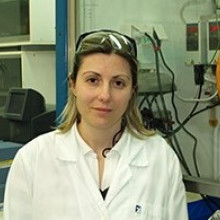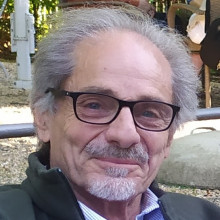
Ph.D. dissertation carried out at IESL-FORTH, entitled "Synthesis and Characterisation of Hybrid Nanocrystal Structures with Tailored Properties" (2012); degree awarded by the University of Crete (Dept. of Chemistry).
Education
- 2006, M.Sc. Physics and Technology of Materials; Aristotle University of Thessaloniki, Greece
- 2004, B.Sc. Physics; Aristotle University of Thessaloniki, Greece
Interests
- synthesis and understanding of high quality magnetic nanocrystals
- nanoparticle assembly - nanoclusters
- secondary colloidal nanostructures for bio-imaging (cf. MRI)
Position Description
Διεξαγωγή πειραμάτων XUV - PUMP, XUV - PROBE με χρήση τεχνικών tagging του CEP
Για το πλήρες κείμενο της πρόσκλησης ακολουθήστε τον σύνδεσμο 'Related Documents'
Related Project
HELLAS - CH -Required Qualifications
- Πτυχίο στην φυσική
- Μεταπτυχιακό στην Φυσική σχετικό με το αντικείμενο της θέσης
- Εμπειρία σε παραγωγή, χαρακτηρισμό και χρήση παλμών αττοδευτερολέπτων
- Εμπειρία σε πειραματικές μεθόδους μελέτης υπερταχείας δυναμικής
- Καλή γνώση αγγλικής
Application Procedure
Στο φάκελο υποβολής της πρότασης θα πρέπει να εμπεριέχονται τα ακόλουθα:
- Αίτηση (Form Greek στην αριστερή στήλη) με αναφορά στον κωδικό της θέσης και στο όνομα του προγράμματος
- Αναλυτικό Βιογραφικό Σημείωμα
- Ευκρινή φωτοαντίγραφα τίτλων σπουδών
- Βεβαίωση σπουδών υποψήφιου διδάκτορα
Οι ενδιαφερόμενοι καλούνται να υποβάλουν τις αιτήσεις τους και όλα τα απαραίτητα δικαιολογητικά, ηλεκτρονικά στη διεύθυνση hr@iesl.forth.gr με κοινοποίηση (cc) στον Δρ Κ. Καλπούζο kalpouzo@iesl.forth.gr.
Οι αιτήσεις θα πρέπει να αποσταλούν με την ένδειξη: «Αίτηση στο πλαίσιο του έργου HELLAS-CH, της πρόσκλησης εκδήλωσης ενδιαφέροντος με Α.Π. ….. και κωδικό θέσης ….» (όπως αυτός αναφέρεται στον Πίνακα του Παραρτήματος).
Appointment Duration
5 μήνεςFunding

Funding

Abstract
Το Ινστιτούτο Ηλεκτρονικής Δομής και Λέιζερ του Ιδρύματος Τεχνολογίας και Έρευνας (ΙΤΕ-ΙΗΔΛ) στo πλαίσιο εκτέλεσης Προγράμματος «HELLAS CH ELI LASERLAB ΟΠΣ 5002735 ΥΠΟΔΟΜΕΣ» προτίθεται να προχωρήσει, με απευθείας ανάθεση, στην προμήθεια εξειδικευμένου πλακιδίου μετατροπής πόλωσης, κατά λ/4 (οπτικό) το οποίο λειτουργεί ταυτόχρονα για το εύρος μήκους κύματος ακτινοβολίας 370-430 nm και 750-850 nm με τα παρακάτω χαρακτηριστικά
Technical Characteristics
- superachromatic retarder made of quartz and MgF2, 15x15 mm²
- wavelength range 370-430 nm und 750-850 nm
- retardation λ/4±λ/400
- axis variation ±0,4°
- consisting of six single plates
- total thickness approx. 1,8 mm
- mounted with air gaps
- 12 surfaces ar coated for 370-430 nm and 750-850 nm
- Rmax<0,5% per surface
- in ring mount
- outer diameter 25 mm
- length 10 mm
- clear aperture 14,5 mm
Procedure
Προϋπολογισμός δαπάνης : 4.806,00 ευρώ πλέον ΦΠΑ, εκτελωνιστικών και τραπεζικών εξόδων.
Eπί της καθαρής αξίας του τιμολογίου οι ακόλουθες νόμιμες κρατήσεις διενεργούνται υπέρ της Ελληνικής Ενιαίας Ανεξάρτητης Αρχής Δημοσίων Συμβάσεων, μία κράτηση ίση προς 0,06% σύμφωνα με το άρθρο 4 παρ.3 του ν. 4013/2011, καθώς και μία κράτηση ίση προς 3,6% επί του ως άνω ποσού (του 0,06% δηλαδή) υπέρ χαρτοσήμου και ΟΓΑ.
Κριτήριο επιλογής θα είναι η συμφερότερη προσφορά. Θα ληφθούν υπ’όψιν η συμφωνία της προσφοράς με τις τεχνικές προδιαγραφές, η ποιότητα, o χρόνος παράδοσης και εγγύησης, η τιμή.
Contact Persons
Funding

Position Description
Χρήση μικροεπλεγμάτων που κατασκευάζονται με λέιζερ ως ικριώματα για ανάπτυξη κυττάρων και μηχανική ιστών. Τα μικροπλέγματα αντιπροσωπεύουν μια νέα τάξη πορωδών δομικών μετα-υλικών που έχουν μοναδικούς συνδυασμούς ιδιοτήτων όπως χαμηλό βάρος, αντοχή. Ως εκ τούτου, είναι υποψήφια ως μόνιμα ικριώματα για μηχανική ιστών και για ιατρικά εμφυτεύματα. Αυτός / αυτή θα είναι υπεύθυνος για την κυτταρική καλλιέργεια και θα μελετήσει τις κυτταρικές αποκρίσεις (προσκόλληση, πολλαπλασιασμό, διαφοροποίηση).
Για το πλήρες κείμενο της πρόσκλησης ακολουθήστε τον σύνδεσμο 'Related Documents'
Required Qualifications
- Πτυχίο Βιολογίας, Χημείας, Υλικών, Χημικού Μηχανικού ή συναφές
- Μεταπτυχιακό με ειδικότητα στη βιολογία ή βιοϊατρική
- Εμπειρία καλλιέργειας κυττάρων και μοριακής βιολογίας
- Άριστη γνώση της Αγγλικής Γλώσσας
- Συστατική Επιστολή
Application Procedure
Στο φάκελο υποβολής της πρότασης θα πρέπει να εμπεριέχονται τα ακόλουθα:
- Αίτηση (Form Greek στην αριστερή στήλη) με αναφορά στον κωδικό της θέσης και στο όνομα του προγράμματος
- Αναλυτικό Βιογραφικό Σημείωμα
- Ευκρινή φωτοαντίγραφα τίτλων σπουδών
- Βεβαίωση σπουδών υποψήφιου διδάκτορα
Οι ενδιαφερόμενοι καλούνται να υποβάλουν τις αιτήσεις τους και όλα τα απαραίτητα δικαιολογητικά, ηλεκτρονικά στη διεύθυνση hr@iesl.forth.gr με κοινοποίηση (cc) στις κ.κ. Α. Ρανέλλα (ranthi@iesl.forth.gr) και Μ. Φαρσάρη (mfarsari@iesl.forth.gr).
Οι αιτήσεις θα πρέπει να αποσταλούν με την ένδειξη: «Αίτηση στο πλαίσιο του προγράμματος ΒΙΤΑΔ, της πρόσκλησης εκδήλωσης ενδιαφέροντος με Α.Π. … και κωδικό θέσης … » (όπως αυτός αναφέρεται στον Πίνακα του Παραρτήματος).
Appointment Duration
4 μήνεςPosition Description
Fabrication of micro/nano electronic devices based on spinwave acoustic resonance tranducers using Electron Beam Lithography techniques for spinwave computing applications
For the full announcement, follow the link "Related Documents"
Required Qualifications
- Extended experience in fiber optical breadboards
- Extended experience in Implementation of space projects
- Experience in constructing thermal testing aparatus
Desirable Qualifications
- Fluent in English
- Experienced in writing ESA related reports or similar
- Experience in evaluating optical elements
Application Procedure
In order to be considered, the application must include:
- Completed application Form (Download link to the left)
- Brief CV
- Scanned copies of academic titles
Interested candidates who meet the aforementioned requirements are kindly asked to submit their applications, no later than March 25, 2020, 23:59 local Greece time to the address (hr@iesl.forth.gr), with cc to the Scientific Coordinator Dr Wolf von Klitzing (wvk@iesl.forth.gr)
Appointment Duration
3 monthsPosition Description
Κατεργασία στερεών υλικών με υπερβραχείς παλμούς Λέιζερ
Για το πλήρες κείμενο της πρόσκλησης ακολουθήστε τον σύνδεσμο 'Related Documents'
Required Qualifications
- Πτυχίο Φυσικής ή Επιστήμης Υλικών
- Μεταπτυχιακός Τίτλος (MSc) σε σχετικό πεδίο με το αντικείμενο της θέσης
- Δημοσιεύσεις σε σχετικό πεδίο με το αντικείμενο της θέσης
- Καλή γνώση της Αγγλικής γλώσσας
Application Procedure
Στο φάκελο υποβολής της πρότασης θα πρέπει να εμπεριέχονται τα ακόλουθα:
- Αίτηση (Form Greek στην αριστερή στήλη) με αναφορά στον κωδικό της θέσης και στο όνομα του προγράμματος
- Αναλυτικό Βιογραφικό Σημείωμα
- Ευκρινή φωτοαντίγραφα τίτλων σπουδών
- Βεβαίωση σπουδών υποψήφιου διδάκτορα
Οι ενδιαφερόμενοι καλούνται να υποβάλουν τις αιτήσεις τους και όλα τα απαραίτητα δικαιολογητικά, ηλεκτρονικά στη διεύθυνση hr@iesl.forth.gr με κοινοποίηση (cc): στον Δρ Εμμ. Στρατάκη (stratak@iesl.forth.gr).
Οι αιτήσεις θα πρέπει να αποσταλούν με την ένδειξη: «Αίτηση στο πλαίσιο του έργου NanoRoll της πρόσκλησης εκδήλωσης ενδιαφέροντος με Α.Π. … και κωδικό θέσης … » (όπως αυτός αναφέρεται στον Πίνακα του Παραρτήματος).
Appointment Duration
8 μήνεςTo: 03/07/2020 20:15
OPTO-CH 2020
meets IPERION-CH.gr
29 JUNE- 03 JULY ● 2020
IESL-FORTH, Heraklion, Crete, Greece
Join us for an exciting journey to Crete to become acquainted with the latest developments on non-invasive optical technologies and explore their field applications in Cultural Heritage research and conservation.
Dear colleagues,
due to the measures taken for Covid-19 outbreak, the OPTO-CH 2020 summer course, initially organized for June 29 - July 3, 2020, is cancelled.
We would like to thank the invited speakers for accepting to contribute to this summer school and all applicants who have already sent their application forms and letters of intent.
A new thematic will be designed for OPTO-CH 2021 so please stay tuned for further information and announcements.
SUMMER COURSE AIMS AND CONTENT
The aim of OPTO-CH 2020 summer course is two-fold:
- to introduce participants to the applications of advanced laser-based technologies in Heritage Science,
- to present the latest developments of IPERION-CH.gr (E-RIHS.gr) the Heritage Science node of the cross-disciplinary National Research Infrastructure HELLAS-CH operating at FORTH.
TIME-LINE:
Application deadline: April 26
Notice of acceptance: April 30
OPTO-CH 2020 summer course: 29 June – 03 July 2020
OUTLINE:
Lectures from experts on modern laser diagnostic and analytical techniques and laser cleaning methodologies will be combined with practical demonstrations and laboratory hands-on sessions. Field experiments on-site at a selected monument in Crete will follow in order to demonstrate the applicability of the techniques in practice.
The last day will be dedicated to IPERION-CH.gr; experts of FORTH researching on a wide range of heritage disciplines will present their work within the interdisciplinary concept of this national RI.
TOPICS
A. LECTURES ON LASER ANALYSIS AND CONSERVATION:
-
Materials analysis with Optical Spectroscopy (LIBS, Raman, Diffuse Reflectance)
-
Optical coherence metrology for structural diagnosis
-
Imaging and mapping; multispectral, photoacoustic and THz
-
Laser cleaning principles and methodologies
B. SPECIAL LECTURE:
Soon to be announced.
PARTICIPANTS:
Maximum number of participants: 15
The OPTO-CH concept relies on a) strong and effective interaction between participants and instructors and b) detailed practical demonstration and hands-on sessions. Therefore participants will be organized in four (3) groups of five (5).
Participants are invited to present case studies they are involved in and discuss challenges that might be addressed by optical diagnostic techniques.
The successful applicants will be selected on the basis of their merit and background.
COST
The course-fee is funded by the HELLAS -CH, a cross-disciplinary National Research Infrastructure (NRI).
Travel, accommodation or subsistence expenses should be covered by the participants.
LANGUAGE:
English
————————-
GDPR
By Participating, You Declare That You Are Informed About The Collection And Use Of The Aforementioned Video/Audio Data And You Consent.
If You Would Like To Learn More About Our Privacy Policy And Your Rights, You Can Visit Our Website (Https://Www.Forth.Gr/_gfx/Pdf/PrivacyPolicy_EN.Pdf).
Position Description
Fabrication of micro/nano electronic devices based on spinwave acoustic resonance tranducers using Electron Beam Lithography techniques for spinwave computing applications.
For the full announcement, follow the link "Related Documents"
Related Project
CHIRON -Required Qualifications
- University Degree in Physics
- At least five years working experience in micro/nano electronics cleanroom environments
- At least five years working experience in Electron Beam Lithography
Application Procedure
In order to be considered, the application must include:
- Completed application Form (Download link to the left)
- Brief CV
- Scanned copies of academic titles
Interested candidates who meet the aforementioned requirements are kindly asked to submit their applications, no later than March 24, 2020, 23:59 local Greece time to the address (hr@iesl.forth.gr), with cc to the Scientific Coordinator Dr George Konstantinidis (aek@physics.uoc.gr)
Appointment Duration
8 monthsFunding


2020 - present: ONRG post-doctoral fellow at IESL-FORTH; aims to develop solvo-thermal growth approaches and the understading of the global structure modifications, pertaining to the Tc evolution in intercalated, expaned-lattice FeSe-based supercoductors.
Education
- 2019, Ph.D. Chemistry; University of Leeds, UK
- 2015, M.Sc. in Industrial Chemistry and Introduction to Chemical Research; Universitat Autonoma de Barcelona, Bellaterra, Spain
Interests
- spin-crossover molecular materials
- light-induced switching in metal-organic frameworks
- magnetic materials and magnetism
- organometallic chemistry
- X-ray crystallography
- perovksites & energy conversion



